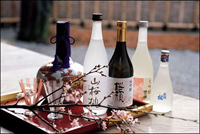The Past - Part 6 - 1960 AD: The birth of "premium" sake

Roughly 50 years ago, the next big “movement” for sake came in the form of Ginjo. Prior to this time, sake was largely considered unrefined. Course, rough, sweet, chunky, bombastic, gritty, sour, and just plain bad; the average brew drank like a syrup or foul potion rather than the light, clean efforts we know today. Sake was heavy, full, and robust, which was widely accepted as the industry norm. But the advent of a new technique forever changed the face of sake.
Some breweries—for example the Niigata Prefecture—decided to mill or polish their rice to incredible levels up and beyond the normal 10 to 20% removal levels. In their efforts to make outstanding sake for the National Sake Appraisal they made brews that were lighter, drier, and far more refined than previous generations of sake. By milling more and more of the rice, their efforts became more elegant and delicious. The industry took note. One brewery was quoted as saying, “Our competition sake is so good that we must share this with our customers.” So began the Ginjo boom.
The new found love affair with milling and polishing rice to smaller and smaller sizes meant that a category system was needed to distinguish between super refined brews and those made for everyday drinking. There are three basic ways to perceive every sake brewed. First by determining what ingredients are used, i.e. what rice-type and how much it has been polished or milled. Second by determining how the ingredients are used, i.e. brewing methods Yamahai or Sukojo. And third by determining how the sake is treated after the fermentation cycle, i.e. pasteurized, diluted, or filtered.
The rush to the milling or polishing frenzy accounted for a classification system called the “Special Designation Sakes” that had a historical minimum milling level of 70% where at least 30% of each grain of rice was polished away. Thus, consumers were now introduced into categories of sake based on how much time and effort went into the brew, and as a result the values of sake shot up considerably. How could a brewery charge the same amount for a brew that was milled to 80% as they would for one milled to 50%? Logically, the time and labor alone would not justify this difference.
Two perceptions of sake evolved out of this Ginjo movement: premium sake and table sake. The industry, which numbered about 3,000 breweries at the end of the war, has since been reduced to about 1,400 breweries. Today, breweries are split between major national makers and small micro-breweries known as jizake. Smaller breweries tend to make sakes that are premium hand-crafted brews while the large national breweries tend to table sake for everyday consumption.
In the last 50 years the quality of sake has gone through the roof! It has been a Golden Era in the mastering of technique for making great sake. It also has made brewing far more difficult and labor intensive than making standard sakes of days gone by. This fact is not lost on an aging population of sake makers. The “graying” of the industry has gone hand-in-hand with a very stiff market for all alcohols. Sake is not Japan’s drink to the Japanese anymore. It is just another booze to choose from amongst a plethora of alcohols.
From “chew in the mouth” sake, to a brew that is made using a highly crafted varietal of brewing rice that is milled down to 35% is a leap in history. However, one simple fact remains—both are nihonshu and both have a place in the timeline of an ancient beverage made of rice and water.


























